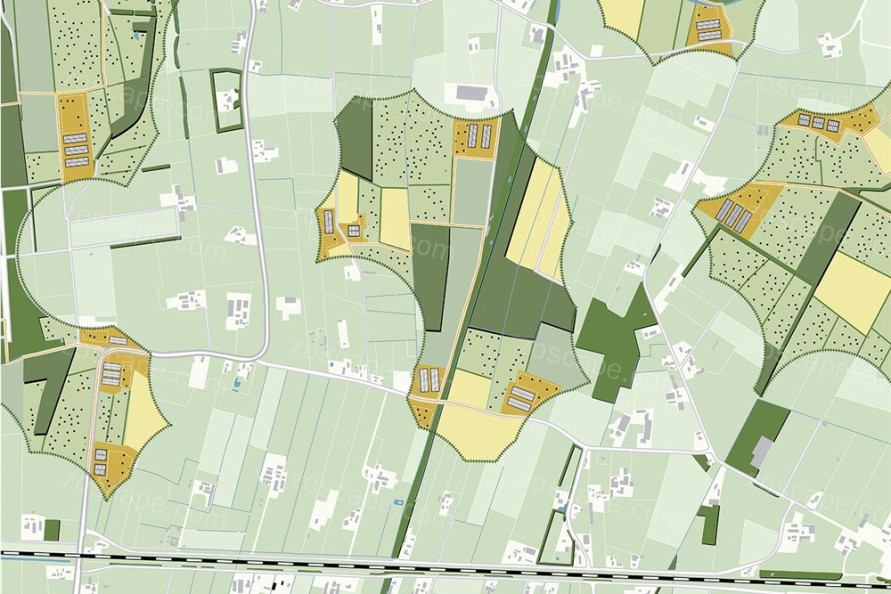Project Name: Regional Biofarming荷兰区域休闲农业园区景观规划设计 Design: 荷兰 Project Type: 都市农业景观规划设计 生态农业园区 新农村规划 休闲农业园 Key words: 农田景观 生物农业 景观设计 观赏农业景观 休闲农业园 景观 地域 农业景观 乡土景观 畜牧业景观 农业 自然环境 田园景观 农业生产 农耕文化 乡村旅游 休闲观光农业 休闲农业 旅游农业 都市农业园 现代农业 都市农业 生态农业 农业园区 农业园 农业观光园 All photos :© SelgasCano 文字/翻译zoscape |
' `" {% F- D- T7 D9 {- d# N
荷兰区域休闲农业园区景观规划设计

4 s3 A1 u. J" G* A+ `, z
7 \. u2 g. A9 P4 p8 I7 r2 D. D
荷兰区域休闲农业园区景观规划设计

2 d9 a' z% F" I) v
, ^2 }+ N$ |* C: _, [
Regional Biofarming荷兰区域休闲农业园区景观规划设计

3 L8 M1 }) h! U' o t. `2 q' z
荷兰区域休闲农业园区景观规划设计

9 K0 U$ R- s& w3 N! k; t
. b: X) {( j' p# D
& j/ q0 ^: A6 E
农田景观具有生产和观赏功能,而且也为游客观赏农业景观、体验农事活动提供了条件,同时还具有展现乡村特色的功效。/ ?; K: w+ g8 p8 P' v
$ I: s4 u: V$ F% V1 i
3 j3 _5 w6 ] a
Regional Biofarming是荷兰具有代表性的集休闲农业观光,肉禽类养殖生产加工为一体的大型综合农业园区。之前的园区是荒凉的养猪场、农产品价格不高,生产效率低下。规划设计师围绕:如何大幅提高销售利润,有一个美丽的休闲观光农业风景和一个健康的肉类和鸡蛋生产展开了设计。
& g S9 V4 }6 Z7 x9 {0 J2 C
荷兰区域休闲农业园区景观规划设计

6 E' h* [0 t1 g- v
/ A: b: l4 c4 @2 l' w* S$ n
Regional Biofarming荷兰区域休闲农业园区景观规划设计

+ a' Q/ D& c, s& k, X# @1 m9 @. r5 m, B8 b1 [) ?# b# t f0 O
Regional Biofarming荷兰区域休闲农业园区景观规划设计

2 s# g$ [" n, O2 k8 [' t7 C1 O" ^/ m& x8 F$ r* [0 m
: L3 F2 A4 K; M2 D
荷兰区域休闲农业园区景观规划设计

9 s- E$ I) f j$ _$ c- r& f4 L# ?: W) H/ r
9 w7 ]3 |+ Y( i
& o- b& w# [+ n7 ?0 A3 _( [
规划设计师规划了室外养猪场,生产猪肉和蛋的新方法正在进行中。这些新的思维方式和生产方式是很小的规模和局部的,不对生产和消费的完整链的一个很大的影响。景观设计师提出了把猪再外面放养,而不是放在谷仓。猪创造了一个全新的农业景观,并且为好奇游客开放。
, |0 @8 q; M6 [" p) b5 n2 E' z% f ?( k3 d
荷兰区域休闲农业园区景观规划设计

3 K; v. G/ A0 `! U: d1 q! j8 C% u {
Regional Biofarming位于城市近郊区,接近田野乡村,因而具有特色地域特征。休闲农业园内部地形复杂,有自然和人工地形。分为山地、平原、丘陵、盆地、岛屿;人工地形是按照景观工程建设需要,对自然地形进行改造,创造出符合景观需求的地形条件。地形是影响休闲农业园景观规划建设的重要因素,在其规划时,景观设计师尊重原有地形,进行选择性保留,合理组织竖向规划,利用地形起伏创造不同层次、风格的农业景观。在高低起伏的地区,景观设计师充分利用地形高差,设计成高低错落、层次丰富的农业景观;在地形平坦的地区,景观设计师设计游步道和田间小路,供游人参观、休闲、健身。
& J) v9 R; Y0 O( N7 D) B
4 z- D ~# @2 [" X; M- s3 ]' C ?8 F- J
; M9 D9 g5 ~+ z a; ?1 I! m9 x$ v% d8 Q! g# o* b! X
" Y8 o* B3 N K, x0 \0 a
7 U; q" b" i: \; U* y5 n$ E+ T7 X
( B# l; h- G2 Q$ g, L s" ?3 F% ?Both consumers and producers are ready for a new approach to animal faming in the Netherlands. The focus nowadays is more and more on the welfare of animals. Take for instance the star-labels of Dierenbescherming. This new awareness has to be taken seriously and now also offers opportunities for farmers, if they are willing to notice it. New ways to produce pig meat and eggs are taking a flight. ( |1 N* ~/ s' S/ O2 {# G
荷兰区域休闲农业园区景观规划设计

$ M5 X8 b, J4 A7 O7 c* l
These new ways of thinking and producing are often very small scale and local, and don’t make a big impact on the complete chain of production and consumption just yet. LOLA wants to contribute to this impact and researched / designed two new ways to produce biological pig meat and eggs at a regional scale. The first step is to get rid of the present 136 Agriculture Development Areas (Landbouwontwikkelingsgebieden), since their location is often not logical and the last years have proven that these areas don’t work. Instead, the proposal is to install 22 sustainable farming regions. Each of these regions produce as local and biological as possible. Generic eggs become Barnevelder eggs, generic pig meat becomes Bonte Bentheimer meat. / }0 b! J9 \& N# o6 E& C$ v
$ g2 t1 z0 Z0 C$ F
For one of these regions, two concepts have been put into practice. One is called Koplopers: a landscape structure of biological farmers estates. These estates host exemplary, innovative biological pig farms in a pleasant, public setting. The other one is called Fijnproevers. It proposes to bring pigs outside again, instead of keeping them in barns. Pigs love to be outside and be social amongst each other. Let them roll in the dirt, let them act out as a group. This is possible, when the farming area is at distance from housing areas, and in areas with a yearly shifting use of grain production, pig farming and nature development. The pigs create a whole new landscape, that is open for visitors.. f6 V, V' R( \ _
" z- l0 I$ u+ m- x; Y0 l3 u- q2 [- |1 F2 M
: G' C4 y7 ^. i _
|